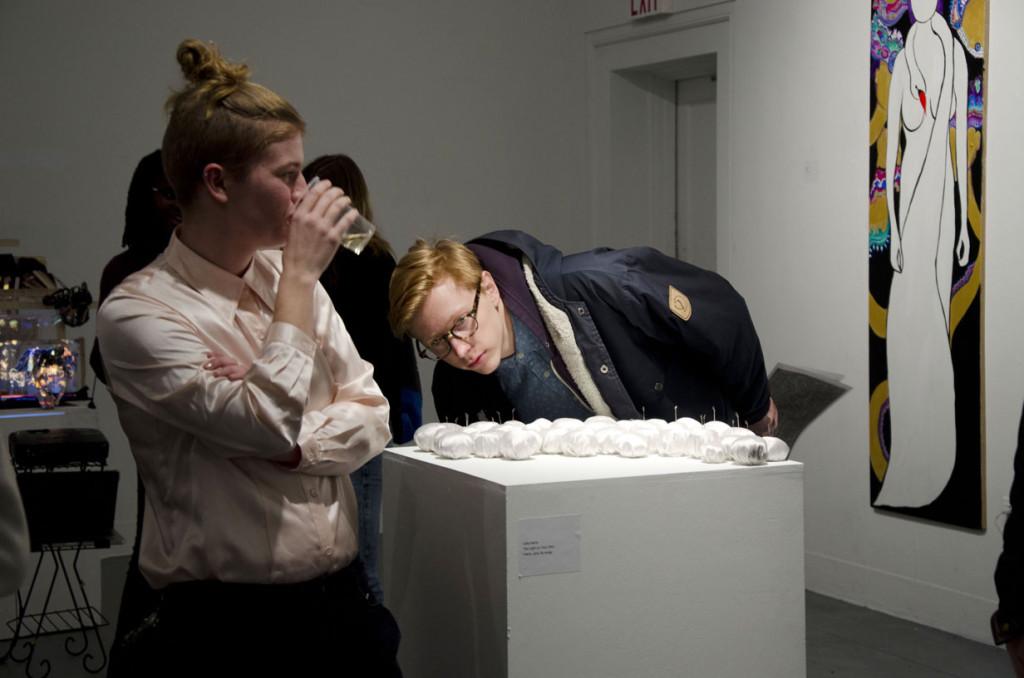Senior Studio Half-Time Show Amps Anticipation for Spring Exhibitions
College seniors MJ Robinson and James Scott take a close look at a sculptural work by fellow College senior and artist Julia Harris at the annual Half-Time Show. The event featured student works produced during the first semester of the Art department’s Senior Studio capstone program.
December 13, 2013
A cult leader cleansing the energy of Fisher Gallery with sage, an ominous cutout representation of gender neutrality and a striking series of nude self-portraits were among the spectacles to behold at this year’s Senior Studio Half-Time Show. On an evening when campus was teeming with student art events, the Allen Memorial Art Museum’s courtyard buzzed with excitement surrounding the nearby exhibition.
The show was part of the Senior Studio capstone seminar, a newly required program for all Studio Art majors which is hosted every December to exhibit student projects from the fall semester. Though highly anticipated, the annual exhibition often proves challenging for audiences due to its lack of a specific theme. Friday night’s show, however, found its strength in the sheer diversity of media, material and process.
The exhibition guided visitors around the gallery on a path that both complemented the featured minimalist works and supported the more confrontational pieces. All in all, the Half-Time Show successfully showcased the varied artistic achievements of a talented group of Studio Art majors, ranging from personal narrative to theoretical considerations.
The show’s most memorable pieces stood on their own, offering stimulating visual complexity and engaging with both academic and art historical references. MJ Robinson’s Presence and “We Don’t Have Much in Common Anymore,” a cutout installation with a corresponding comic available in multiple copies for gallery visitors, took an interesting approach to identity politics. Robinson explored pronoun identification, a much-discussed topic at Oberlin, in a subtle but memorable tone.
Mary Okoth’s untitled video fostered a similarly strong sensation, with her installation in Classroom II allowing for an intimate, encapsulating experience. Projected in a space framed by sheets, the video featured layered voices of obscured, anonymous figures describing experiences of migration.
The show’s most striking work of sculpture was Conor Donahue’s “Untitled,” a collage of found objects that sprang up like a 3D amalgamative rendition of his cartoonist illustrations. The endearing piece was pointedly reminiscent of Mike Kelley’s work from the late 1980s, particularly in light of the piles of scattered toys and partially melted candlesticks.
That being said, some of the works included fell victim to the entrapments of an insular liberal arts community. Though thoughtful use of material and commendable attention to detail saved the Half-Time Show from any real danger, unfortunately, some of the subject matter was slightly unoriginal and seemed borrowed from past classes.
Running themes found in the Senior Studio shows from year to year have the capacity to become monotonous if not checked. Claire Morton’s exploration of cult mysticism in “Ash Ray,” though executed with brilliant concentration, a commanding presence, and impressive prop orchestration, dealt with a subject matter that is recurrent on a frequent basis at Oberlin. Last year, “Cooling the Babylon Matrix” by Lily Gottschalk, OC ’13, incorporated much of the same astrological mystic imagery and similar multi-media video components, though it was notably less narrative, more comprehensive and reliant on audience participation in ways that Morton’s performance was not.
College junior Taylor Herman’s performance, while cleverly timed and humorously low-key, fell in line with the history of intervention and distraction at Senior Studio exhibitions.
Likewise, other visual themes and iconography reappear from previous years; this time around, Annika Stridh’s bird nest shrouded by delicate wire recalled Hannah Klein’s post-minimalist sculptures of nests cocooned in thin fabric and layered string from 2012’s Senior Studio show “For/Giving”.
While artists working in close proximity are bound to exert some influence over one another, the adoption of specific tropes within the studio art community becomes problematic when reinterpretations fail to expand. In such a small department, popular jargon (think “memory,” “archive,” “histories”) tends to become too deeply imbedded, making it more difficult to access ideas outside of the established language and imagery of Oberlin.
Though there was perhaps excessive reliance on Oberlin studio art traditions, the Half-Time Show was ultimately an exciting preview of projects to follow for individual exhibitions in the spring. As a whole, the group is enormously gifted in terms of craft and execution, with great potential to make beautiful, engaging, subversive work — that is, if they can reach just a little bit further outside of our campus bubble.
















